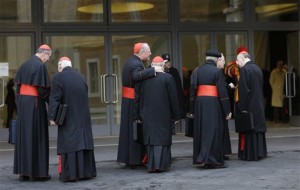
Cardinals, including U.S. Roger Mahony, left, and Timothy Dolan, third from left, arrive for a meeting at the Vatican, Monday March 11, 2013. Cardinals have gathered for their final day of talks before the conclave to elect the next pope amid debate over whether the Catholic Church needs a manager pope to clean up the Vatican’s messy bureaucracy or a pastoral pope who can inspire the faithful and make Catholicism relevant again. AP PHOTO
VATICAN CITY—Cardinals prayed for unity and pledged allegiance to whoever will be the next pope at a grandiose mass in St. Peter’s Basilica on Tuesday ahead of a conclave to elect a new leader for the Catholic world.
The dean of the College of Cardinals, Angelo Sodano, celebrated the special papal election mass, telling the 115 scarlet-robed cardinals preparing to elect the 266th pope: “Each of us must work to build up the unity of the Church.”
Sodano also prompted thunderous applause when he evoked Benedict XVI, who stunned the world by resigning abruptly last month after an eight-year pontificate often overshadowed by Vatican infighting.
Sodano referred to the “beloved and venerable” Benedict — the first pope to resign in over 700 years and only the second to step down by choice in some 2,000 years of Church history.
As the cardinals prayed, a rainstorm drenched thousands of pilgrims watching the momentous event on four giant screens in St. Peter’s Square.
The “Princes of the Church” will be cut off from the outside world inside the Vatican walls until they have made their choice in a centuries-old ritual — much of it carried out in Latin.
They took to Twitter to say their goodbyes to their online flock before the conclave, where jamming devices will block any communications.
“Last tweet before conclave: May Our Father hear and answer with love and mercy all prayers and sacrifices offered for fruitful outcome. God bless!” South African cardinal Wilfrid Napier said.
The cardinals are sworn to secrecy with a solemn oath that threatens anyone who reveals the contents of their deliberations with excommunication.
They will enter the Sistine Chapel in a procession starting at 1530 GMT, chanting in Latin to invoke divine guidance for the vote.
The cardinals are then set to hold a first round of voting — but the Vatican has already said it expects the smoke from the burning of the ballots in a special stove in the chapel to be black, indicating no pope has been elected.
From Wednesday, ballots will be burnt after two rounds of voting in the morning and after two rounds in the afternoon — the smoke above the Vatican is famously turned white if there is a new pope.
Conclaves normally last no more than a few days and a two-thirds majority is required.
“The Church is like a boat, all the faithful are sailing in it together but we’re without a helmsman at the moment,” said Celestina, 62, a nun from Croatia, praying in a church near the Vatican.
Among the possible candidates, three have emerged as favorites — Italy’s Angelo Scola, Brazil’s Odilo Scherer and Canada’s Marc Ouellet, all of them conservatives cast in the same mould as “pope emeritus” Benedict XVI.
But the rumor mill in the Vatican has thrown up more names including cardinals from Austria, Hungary, Mexico, the Philippines, South Africa and the United States — many of them inspiring pastoral figures in their communities.
Mexican cardinal Norberto Rivera Carrera told Italian daily La Stampa that there was no agreement yet among the cardinal electors on what type of candidate they wanted.
“Some imagine him to be more academic, able to establish a dialogue with culture. Others ask for someone who is close to the people. Others still want someone with more authority to put some Church problems in order,” he said.
“So far, there is no majority,” he said.
Although the field is wide open, a few key aims unite many of the cardinals — reforming the intrigue-ridden Vatican bureaucracy, countering rising secularism in the West and re-igniting Catholic faith in the way Benedict’s charismatic predecessor John Paul II did.
The scandal over decades of sexual abuse of children by paedophile priests — and the efforts made by senior prelates to cover up the crimes — has cast a long shadow over the Church.
British cardinal Keith O’Brien had threatened to overshadow the conclave after claims surfaced of sexual misconduct with priests and seminarians in the 1980s, but the prelate quickly withdrew before the cardinals gathered in Rome.
There have been calls too from within the Church for a rethink of some basic tenets such as priestly celibacy, the uniform ban on artificial contraception and even allowing women to be priests as in other Christian denominations.
A series of pre-conclave meetings of cardinals last week offered a rare chance to air grievances against the Vatican, and Italian media on Tuesday reported a clash between two senior cardinals in one meeting over what to do about the Vatican’s scandal-tainted bank.
The tradition of holding conclaves goes back to the 13th century when cardinals were locked into the papal palace in Viterbo near Rome by a crowd of angry townspeople because they were taking too long to choose a pope.
That conclave still dragged on for nearly three years but the rules have been reworked since then and the longest conclave in the past century — in 1922 — lasted only five days. Benedict’s election took just two days.
The frail Benedict announced on February 11 that he no longer had the strength of body and mind to keep up with the modern world.
In a series of emotional farewells, the 85-year-old German said he would live “hidden from the world” and wanted only to be “a simple pilgrim”.
Vatican experts have said Benedict’s decision could mean future popes will also step down once their health fails.